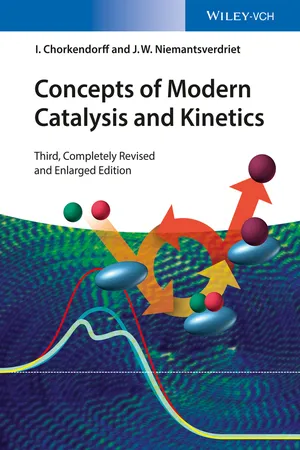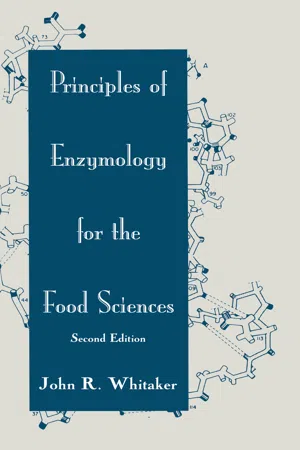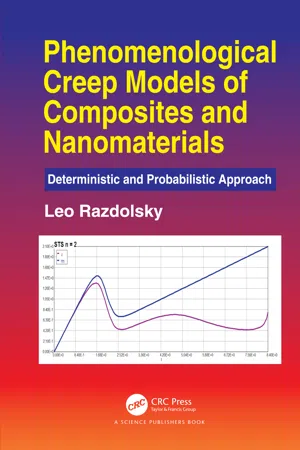Chemistry
Rate Equations
Rate equations in chemistry describe the speed at which a chemical reaction occurs. They are mathematical expressions that relate the rate of a reaction to the concentrations of reactants. Rate equations are often determined experimentally and can provide valuable insights into the mechanisms of chemical reactions.
Written by Perlego with AI-assistance
Related key terms
7 Key excerpts on "Rate Equations"
- eBook - ePub
- Patrick E. McMahon, Rosemary McMahon, Bohdan Khomtchouk(Authors)
- 2019(Publication Date)
- CRC Press(Publisher)
22 Kinetics Part 1 Rate Laws, Rate Equations, and an Introduction to Reaction MechanismsI GENERAL CONCEPT OF KINETICS Kinetics is the study of rates of complete reactions by mathematical and experimental analysis to determine reaction mechanisms. A reaction mechanism is a description of the bonding events that occur along the pathway reactants follow to form products.Rates of reaction are measured by quantifying concentration changes, either the disappearance of a reactant or the appearance of a product as a function of time (t):rate (r ) = − Δ [ reactant ] / Δt or rate (r ) = + Δ [ product ] / ΔtRates of reactions are generally proportional to the concentration of one or more of the reactants raised to a specific power (exponent); This relationship is termed the rate expression or rate law:rate ( r ) = k[ reactant 1 ]X. . . .[ reactant 2 ]YThe constant in the expression is called the rate constant, k; the numerical values of the exponents x, y, and so on, are called the reactant orders. For example, if x = 2 in the above general expression, the reaction is “second order in reactant 1.”The sum of all the exponents x + y… is called the reaction order. For example, if x = 2 and y = 1 in the above general expression, the reaction would be described as a “third-order reaction.” The values of k, x, y… depend on the reaction mechanism.ADDITIONAL VARIABLES AFFECTING REACTION RATESRates are inversely proportional to the energy barriers that prevent a specific reaction or reaction step from occurring; this barrier is called the activation energy, or activation barrier, for the reaction or step (general symbol: Ea).The activation energy, Ea, represents the energy that must be added to reactants to allow bonding changes to occur.A reaction rate will increase as the activation energy (barrier) decreases. Ea is a path function and does not depend directly on the value of the energy change for the complete reaction. The specific Ea, which is most important for a complete reaction containing many steps, depends on the reaction mechanism. - eBook - ePub
Physical Chemistry
How Chemistry Works
- Kurt W. Kolasinski(Author)
- 2016(Publication Date)
- Wiley(Publisher)
CHAPTER 16 Empirical chemical kineticsPREVIEW OF IMPORTANT CONCEPTS
- A rate law relates concentration to time in terms of the concentrations of the species involved in the reaction. The differential form describes the rate of change of concentration with respect to time. The integrated form describes concentration as a function of time.
- We need to differentiate between elementary reactions (ones that occur in a single step) and composite reactions (ones that are composed of a series of elementary steps).
- For an elementary reaction, the kinetic order of reaction is always the same as the molecularity, the partial order with respect to a specific reactant is the same as its stoichiometric coefficient, and products do not appear in the rate equation.
- The kinetic order of a composite reaction is not directly related to the stoichiometry of the balanced chemical reaction.
- A reaction mechanism is a series of elementary reactions that adds up to the stoichiometry of the composite reaction.
- A rate-determining step is the elementary step in the reaction mechanism that has the greatest influence on the reaction rate.
- The rate constant is a positive number, the units of which depend on the reaction order. Many rate constants exhibit Arrhenius behavior, which means they have a temperature dependence given by the Arrhenius equation.
- Thermodynamics determines the concentrations of reactants and products at equilibrium. Kinetics describes the rate of evolution of a system. It determines how long it takes for a system to achieve equilibrium, if at all.
- Collisions almost invariably precede reaction, and the collision rate represents an upper limit to the rate at which a reaction can occur.
- Only collisions that have sufficient energy and which satisfy the proper geometry lead to reaction.
16.1 What is chemical kinetics?
Chemical kinetics is the measurement and description of the rates of chemical reactions. It seeks to develop mathematical equations that describe and predict the course of chemical reactions in terms of the species involved in the reaction. The mathematical equations are called rate laws - eBook - ePub
- I. Chorkendorff, J. W. Niemantsverdriet(Authors)
- 2017(Publication Date)
- Wiley-VCH(Publisher)
ab initio theoretical chemistry, and transition state theory. It is at this level that we can learn what determines whether a chemical reaction is feasible.In practical situations, we are not interested in the single event but in what happens in a large ensemble of molecules. We therefore have to average over all possibilities, that is, over all energies and coordinates of the reacting molecules. This is what kinetics is about. Temperature is the parameter that suitably describes the average energy content of the molecules participating in the reaction. Thermodynamics determines the changes in free energy that accompany a reaction and sets limits to the fraction of molecules that can be converted. Thus, kinetics describes the behavior of large ensembles of molecules during a reaction.2.2 The Rate Equation and Power Rate Laws
Suppose a reaction between molecules A and B gives product molecules C and D according to the reaction equation(2.1)with forward and backward rate constants, k+ and k− , and stoichiometric coefficients νa , νb , νc , and νd . The rate of reaction is defined as the rate of disappearance of the reactants, or the rate of formation of products:(2.2)where [X] stands for the concentration of component X. If the reaction occurs in the gas phase, we may replace the concentrations by partial pressures: [X] ∝ pX /p◦ , where p◦ is the reference pressure (p◦ = 1 bar).(2.3)Very often, we will not include the reference pressure, p◦ , but implicitly assume that p represents a relative quantity.A reaction is elementary if it occurs in a single step that cannot be divided into any further substeps and proceeds exactly as expressed by the reaction equation (Eq. (2.1) ). For an elementary step, the rate equals(2.4)in which k+ and k− - eBook - ePub
- Steven Boone, Drew H. Wolfe(Authors)
- 2011(Publication Date)
- Collins Reference(Publisher)
CHAPTER 14Rates of Chemical Reactions
C hemical kinetics , also called reaction kinetics , is the study of the rates of chemical reactions and the underlying mechanisms by which reactants change to products. An important outcome for studying the rates of chemical reactions is to develop an understanding of how chemical reactions take place. Chemists attempt to identify the molecular events that occur as reactants change to products. The series of steps that take place in a reaction is termed the reaction mechanism .14.1 RATES OF CHEMICAL REACTIONSThe enthalpy and entropy change in a chemical reaction is used to predict the spontaneity of the reaction (see Chapter 18), however, it provides no information regarding how long the reaction will take to reach completion, which is kinetics.Reaction RatesA rate refers to a change that occurs over a time interval. Chemical reaction rates may be monitored by measuring the change in concentration or pressure of a reactant or product over a time interval. Recall that the Greek letter delta, Δ, is used to represent a change. Therefore, this expression may be represented as follows.Exercise 14.1Consider the rate of the gas-phase reaction when nitrosyl fluoride, ONF, forms from F2 and NO.F2 (g) + 2NO(g) → 2ONF(g)(a) Write an expression that shows the rate of formation of ONF. (b) What are the units of reaction rate? (c) Write an expression that shows the rate of disappearance of NO. (d) Write an expression that shows the relationship between the rate of formation of ONF and rate of disappearance of NO. (e) Write an expression that shows the relationship between the rates of disappearance of F2 - Charles G. Hill, Thatcher W. Root(Authors)
- 2014(Publication Date)
- Wiley(Publisher)
Unfortunately, there is no completely general method of determining the reaction rate expression or even of determining the order of a reaction. Usually, one employs an iterative trial-and-error procedure based on intelligent guesses and past experience with similar systems. Very often the stoichiometry of the reaction and knowledge of whether the reaction is “reversible” or “irreversible” will suggest a form of the rate equation to try first. If this initial guess (hypothesis) is incorrect, the investigator may then try other forms that are suggested either by assumptions about the mechanism of the reaction or by the nature of the discrepancies between the data and the mathematical model employed in a previous trial. Each reaction presents a unique problem, and success in fitting a reaction rate expression to the experimental data depends on the ingenuity of the individual investigator.The discussion that follows is largely confined to irreversible reactions with simple rate expressions of the form of equation (3.0.17), but the methods developed are more generally applicable. We have chosen this approach to keep the discussion as simple as possible and to present the material in a manner that avoids the introduction of more complex rate expressions. Most of the methods presented below are applicable regardless of the mathematical form of the rate expression, and they may readily be extended to cover the rate expressions that will be encountered in Chapters 6, 7 and 13.The techniques used to determine reaction rate expressions may be classified into three general categories:- Integral methods based on integration of the reaction rate expression. In these approaches one customarily analyzes the data by plotting some function of the reactant concentrations or the extent of reaction versus time using coordinates that would yield a straight line if the hypothesis concerning the mathematical form of the rate expression is correct.
- Differential methods based on differentiation of experimental concentration versus time data to obtain an approximation to the actual rate of reaction. In these approaches one analyzes the data by postulating various functional relations between the rate of reaction and the concentrations of the various species in the reaction mixture and tests these hypotheses using appropriate plots of the data.
- Methods based on simplification of the reaction rate expression. In these approaches one uses stoichiometric ratios of the reactants or a vast excess of one or more of the reactants in order to permit a partial evaluation of the form of the rate expression. These methods may be used in conjunction with either a differential or an integral analysis of the experimental data.
- eBook - ePub
- John R. Whitaker(Author)
- 2018(Publication Date)
- Routledge(Publisher)
(1), (4), and (10) ] are unity. Consider the case of the reversible reaction described by 2A + B ⇌ k − 1 k 1 3P (16) The rates of change of the various molecular species are described by the following rate. equations: 1 2 (− d A d t) = k 1 (A) 2 (B) − k − 1 (P) 3 (17) − d B d t = k 1 (A) 2 (B) − k − 1 (P) 3 (18) 1 3 (d P d t) = k 1 (A) 2 (B) − k − 1 (P) 3 (19) It will be noted. that 1 2 (− d A d t) = − d B d t = 1 3 (d P d t) = k 1 (A) 2 (B) − k − 1 (P) 3 (20) From the specific equations (16) and (20), one may then deduce that the corresponding general equations can be written. as a A + b B ⇌ k − 1 k 1 p P + q Q (21) and 1 a (− d A d t) = 1 b (− d B d t) = 1 p (d P d t) = 1 q (d Q d t) (22) Therefore, when the rate of a chemical reaction may be described by a simple stoichiometric equation, it is possible to define a rate of reaction for the system uniquely. The rate of change in the concentration of A for the forward reaction can then be written in the general form − d A d t = k A a B b C c ⋯ (23) where A, B, and C are concentrations of reactants at any time and the exponents, a, b, and c are coefficients of the balanced equation. This may or may not be true for reactions that go by alternative pathways. The molecular order of the reaction depicted in Eq. (23) is a with respect to A, b with respect to B, c with respect to C, and so on, while the overall (or total order) is the sum of the exponents a + b + c … C. Consecutive Reactions Equation (10) describes a case of consecutive reactions. This equation indicates that enzyme and substrate must combine to form an enzyme-substrate complex, which in turn reacts to form enzyme and product. The enzyme-substrate complex, EA, is an obligatory intermediate in the reaction as written. In the case of consecutive reactions it is valid to write the equation in parts as E + A ⇌ k − 1 k 1 EA (24) EA → k 2 E + P (25) D - eBook - ePub
Phenomenological Creep Models of Composites and Nanomaterials
Deterministic and Probabilistic Approach
- Leo Razdolsky(Author)
- 2019(Publication Date)
- CRC Press(Publisher)
At close values of the rates of individual stages of a complex reaction, a complete analysis of the entire kinetic scheme is necessary. The introduction of the concept of the stage determining the rate in many cases simplifies the mathematical side of the consideration of similar systems and explains the fact that sometimes the kinetics of deliberately complex, multistage reactions is well described by simple equations, for example, of the first or second order. 5.8.4 Reversible reactions of the first order Kinetics of this type are applicable to many simple reactions and the basic equation can be written as: A ↔ k - 1 k 1 B. The expression for the conversion rate of substance A will be written on the basis of the independence principle, denoting the current concentrations as [A] and [B]: By the equation of material balance: (5.46) [ B ] = [ B ] 0 + [ A ] 0 - [ A ] : d [ A ] dt = - k 1 [ A ] + k - 1 [ B ] the solution will have the. form: (5.47) [ A ] = k - 1 ([ A ] 0 + [ B ] 0) k 1 + k - 1 + k 1 [ A ] 0 - k - 1 [ B ] 0 k 1 + k - 1 e - (k 1 + k - 1) t Now the condition of equality of the rates of direct and reverse reactions in equilibrium can be used: k 1 [A] bal = k_ 1 [B] bal or: K = k 1 / k, = [B] bal /[A] bal. Taking this equation into account, the solution for. changing the concentration of substance A in time can be represented as: (5.48) [ A ] = ([ A ] 0 + [ B ] 0) K + 1 + K [ A ] 0 - [ B ] 0 K + 1 e - (k 1 + k - 1) t In order to calculate the change of [B] one can easily get the appropriate expression using the equation of material balance. It is seen that when k -1 = 0 the previous formula goes to the equation of the kinetics of the first-order of irreversible reaction. A quantitative assessment of the possibility of neglecting the reverse reaction can be carried out on the basis of the following reasoning. The rate of the reversible reaction r = −k 1 [A] + k -1 [B] (for an accuracy of 1%) the second term should be 100 times smaller
Learn about this page
Index pages curate the most relevant extracts from our library of academic textbooks. They’ve been created using an in-house natural language model (NLM), each adding context and meaning to key research topics.






